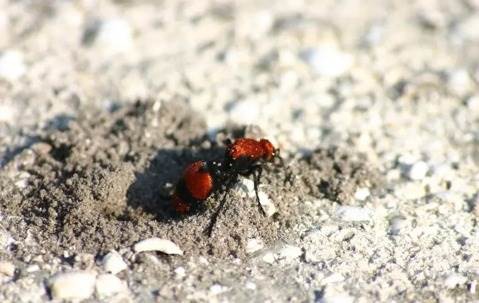Cow Killer Ants in Florida: Characteristics and Control Solutions
Imagine stumbling upon the Cow Killer Ant in your Florida garden, a wingless wasp famed for its excruciating sting. This vibrant insect, often mistaken for an ant, is a sight to behold, yet its sting leaves a memorable impression.
Despite its daunting nickname, it's not naturally aggressive, stinging only when provoked or stepped on. Its striking appearance is a warning; the female searches the ground for nesting spots, occasionally crossing paths with humans.
So, for residents and visitors in Florida, a bit of caution and awareness can go a long way to coexist peacefully and avoid a painfully unforgettable encounter.
Key Takeaways
- The Cow Killer Ant is actually a wasp from the Mutillidae family, not an ant. It's not lethal to cows but is notorious for its excruciating sting.
- Understanding the biology and behavior of these wasps is crucial for residents and visitors in areas where they are common.
- These wasps generally avoid confrontation and only sting when threatened. It's crucial to practice caution to ensure peaceful coexistence.
What Is a Cow Killer Ant?
The Cow Killer Ant is a species of wasp with an extremely painful sting. This section breaks down its unique characteristics and habitat, particularly within Florida.
Identification and Appearance
The Cow Killer Ant, or Dasymutilla occidentalis (Order: Hymenoptera), is not an ant but a wasp species.
Female | Male |
|
|
They have dense orange-red hair on the abdomen and thorax. Their antennae are straight and beadlike.
Habitat and Distribution in Florida
In Florida, the habitat and behavior of the Cow Killer Ant can be summarized as follows:
Habitats
- Sandy areas.
- Suburban neighborhoods.
- Open grasslands.
Geographical Spread
- Widespread across the U.S.
- Parts of North America.
- Thrives in Florida's climate.
Preferences & Activity
- Favors warm, dry conditions.
- Hunts other insects.
- Lays eggs in high insect-populated areas, a common trait in Florida.
Their presence in Florida is notable due to the state's high insect populations, which offer ample food resources.
What Defines the Cow Killer Ant's Behavior and Ecology?
Cow Killer Ants are not ants but solitary wasps. These stinging insects display unique behaviors and undergo distinct developmental stages.
Life Cycle and Development
They are a species of velvet ants that exhibit a captivating life cycle intricately linked to the nests of other insects, like ground-nesting bees and wasps.
- Adult Stage: Female velvet ants lay eggs near or inside the nests of host insects. ? Eggs hatch into parasitic larvae.
- Larval Stage: Velvet ant larvae feed on the host's larvae and spin their cocoon, undergoing several growth stages. ? They turn to pupae within the safety of the host nest.
- Pupation to Adult: After fully developing, adult velvet ants emerge from the host nest. ? They venture out to perpetuate the life cycle.
Diet and Predation
As a parasitoid, a Cow Killer Ant is a predator in its larval stage. It has few predators as an adult due to its tough exoskeleton and painful sting.
Adult Females | Adult Males |
|
|
Predation mainly occurs when birds or other animals overlook these defense mechanisms.
How Do Cow Killer Ants Interact with Humans?
In Florida, the presence of the Cow Killer Ant significantly affects those who come across it. Given its notorious sting, understanding interactions is vital.
The Cow Killer Sting
The velvet ant's sting is renowned for its intense pain. The female possesses a potent venom that can cause discomfort out of proportion with her size.
When you get stung, they often experience a pain described by some as equivalent to actually being 'kicked by a cow,' hence the name.
Entomologists note that the sting's pain, although usually fading, can linger, and immediate relief can be sought by applying ice to mitigate swelling.
What Are Effective Pest Control Strategies Against Cow Killer Ants?
Effective pest control against Cow Killer Ant infestation requires understanding and caution. To keep these encounters to a minimum, consider the following strategies:
1. Environment Maintenance
Regularly clear your property of debris and clutter, which can attract the insects searching for food or nesting spots.
Ensure that your patio and yard are well-maintained, trimming back dense vegetation that might be a hiding place for these wasps.
2. Home Fortification
Diligently seal any openings, like cracks in the foundation or gaps around windows and doors, to prevent these creatures from venturing indoors.
Install insect-proof mesh on windows, doors, and ventilation openings, creating a physical barrier against intruders.
3. Professional Intervention
If you spot them on your property, resist the urge to deal with them yourself. Contacting pest control experts ensures safe and effective removal, safeguarding you from the risks of a sting.
Professional pest controllers can offer tailored solutions and advice on long-term prevention strategies, helping you maintain a wasp-free environment.
Frequently Asked Questions
In this section, you will find answers to common inquiries about the cow killer ant, also known as the Florida velvet ant, and guidance on handling them.
What happens if you get stung by a cow killer ant?
If you get stung by a cow killer ant, you can experience intense pain that usually lasts about 30 minutes. The sting's venom can cause redness and swelling at the site.
Are cow killer ant bites dangerous to humans?
Cow killer ant stings are rarely dangerous to humans without an allergic reaction. While extremely painful, they are generally not life-threatening.
Just how painful is a sting from a Florida velvet ant?
Stings from a Florida velvet ant are described as excruciating, scoring high on the Schmidt Pain Index. They are often compared to a jolt of electricity.
